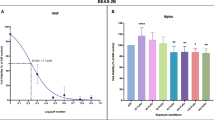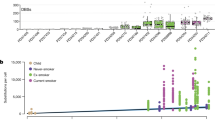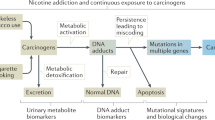Abstract
Smoke condensate from two types of cigarette, dissolved in two solvents, has been applied regularly to the backs of mice at each of seven different dose levels. Treatment was continued 3 times weekly for up to 110 weeks, by which time 509 of the 1428 treated mice had developed skin tumours. The dependence of tumour incidence on age was adequately described by the Weibull distribution. The relation - ship between dose of smoke condensate and tumour incidence rate was, however, erratic. It was less regular than the simple relationship which has in previous work been found to obtain when the pure carcinogen benzo(a)pyrene is applied to mouse skin.
This is a preview of subscription content, access via your institution
Access options
Subscribe to this journal
Receive 24 print issues and online access
$259.00 per year
only $10.79 per issue
Buy this article
- Purchase on Springer Link
- Instant access to full article PDF
Prices may be subject to local taxes which are calculated during checkout
Similar content being viewed by others
Rights and permissions
About this article
Cite this article
Davies, R., Lee, P. & Rothwell, K. A Study of the Dose Response of Mouse Skin to Cigarette Smoke Condensate. Br J Cancer 30, 146–156 (1974). https://doi.org/10.1038/bjc.1974.126
Issue Date:
DOI: https://doi.org/10.1038/bjc.1974.126
This article is cited by
-
Experimentelle Untersuchungen �ber die tumorerzeugende Wirkung von Zigarettenrauch-Kondensaten an der M�usehaut
Zeitschrift f�r Krebsforschung und Klinische Onkologie (1976)



